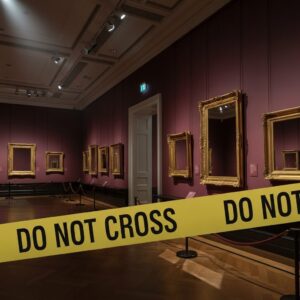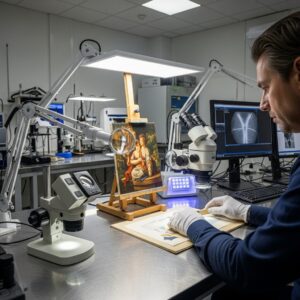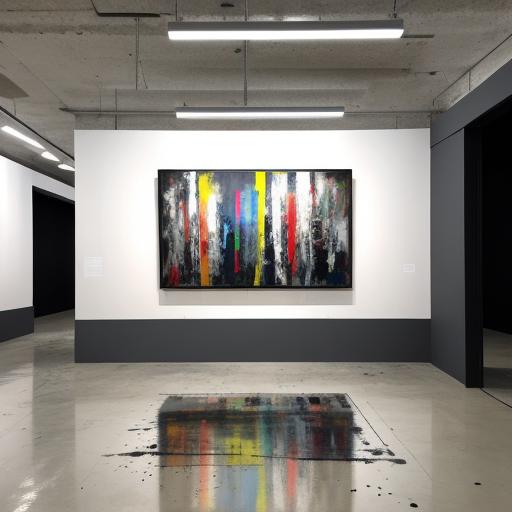Imagine walking into a museum and seeing empty frames where priceless masterpieces once hung. This nightmare scenario has played out in some of the world’s most prestigious museums, creating some of the most notorious famous art thefts in history. From the shocking Isabella Stewart Gardner Museum heist to the brazen theft of the Mona Lisa, these crimes have captivated the public and forever changed how we protect our cultural treasures.
Key Points Summary
- The Isabella Stewart Gardner Museum heist remains the world’s largest unsolved art theft at $500 million
- The 1911 Mona Lisa theft made it the world’s most famous painting
- Modern art security combines traditional methods with cutting-edge technology
- The FBI Art Crime Team recovers millions in stolen artwork annually
- Prevention and authentication are crucial in fighting art crime
The Isabella Stewart Gardner Museum: History’s Greatest Art Heist

On March 18, 1990, two men dressed as police officers convinced security guards to let them into Boston’s Isabella Stewart Gardner Museum. What happened next became the most expensive art theft in history. The thieves spent 81 minutes inside, stealing 13 priceless works worth an estimated $500 million to $1 billion.
The stolen masterpieces included works by Rembrandt, Degas, and Vermeer. The museum’s “Concert” by Vermeer was particularly valuable – one of only 34 known paintings by the Dutch master. Today, empty frames still hang on the museum walls, a haunting reminder of what was lost.
Despite a $10 million reward and thousands of tips, the case remains unsolved. The FBI continues to investigate, making it one of the longest-running art crime investigations in history.
Historic Mona Lisa Theft: When the World’s Most Famous Painting Vanished

Before 1911, Leonardo da Vinci’s Mona Lisa was just another painting in the Louvre. Then Vincenzo Peruggia, an Italian handyman who had worked at the museum, walked out with the painting hidden under his coat. The theft wasn’t discovered until the next day when an artist noticed the empty wall space.
The disappearance made international headlines and turned the Mona Lisa into a global sensation. For two years, the painting was missing while police investigated everyone from Pablo Picasso to American millionaire J.P. Morgan. Peruggia finally tried to sell the painting to an Italian art dealer in 1913, leading to his arrest and the painting’s return.
Surprisingly, Peruggia claimed patriotic motives – he believed the painting belonged in Italy, not France. His theft inadvertently made the Mona Lisa the most famous painting in the world.
Famous Art Thefts That Shocked the World
The Scream Theft: Daylight Robbery in Oslo
In 2004, armed thieves burst into Oslo’s Munch Museum during daylight hours and stole two Edvard Munch paintings, including “The Scream.” Museum visitors watched in horror as the criminals threatened staff and made off with the irreplaceable artworks.
The stolen paintings suffered significant damage during their two-year absence. When recovered in 2006, conservators spent months repairing tears and other damage. The theft highlighted vulnerabilities in museum security systems worldwide.
Nazi Art Looting: The Largest Art Crime in History
Between 1933 and 1945, Nazi forces systematically looted an estimated 650,000 artworks across Europe. This massive cultural theft targeted Jewish collectors, museums, and cultural institutions. The scale was unprecedented – entire collections disappeared overnight.
The famous “Monuments Men” worked to recover stolen art after World War II, but thousands of pieces remain missing. Today, museums and collectors still grapple with provenance research to identify Nazi-looted artwork in their collections.
Top 10 Art Thefts by Value
The Most Valuable Stolen Artworks in History
| Rank | Artwork & Artist | Estimated Value | Year Stolen | Location | Status |
|---|---|---|---|---|---|
| 1 | The Concert Johannes Vermeer (c. 1664) | $250 Million | 1990 | Isabella Stewart Gardner Museum, Boston | Unsolved |
| 2 | The Storm on the Sea of Galilee Rembrandt van Rijn (1633) | $100 Million | 1990 | Isabella Stewart Gardner Museum, Boston | Unsolved |
| 3 | A Lady and Gentleman in Black Rembrandt van Rijn (1633) | $80 Million | 1990 | Isabella Stewart Gardner Museum, Boston | Unsolved |
| 4 | Le Pigeon aux Petits Pois Pablo Picasso (1911) | $28 Million | 2010 | Musée d’Art Moderne, Paris | Unsolved |
| 5 | Portrait of a Young Man Raphael (c. 1513-1514) | $100 Million | 1939 | Czartoryski Museum, Poland (WWII) | Unsolved |
| 6 | Nativity with San Lorenzo and San Francesco Caravaggio (1609) | $20 Million | 1969 | Oratorio di San Lorenzo, Palermo | Unsolved |
| 7 | Chez Tortoni Édouard Manet (1878-1880) | $40 Million | 1990 | Isabella Stewart Gardner Museum, Boston | Unsolved |
| 8 | The Mona Lisa Leonardo da Vinci (1503-1519) | $900 Million* | 1911 | Louvre Museum, Paris | Recovered 1913 |
| 9 | Self-Portrait with Bandaged Ear Vincent van Gogh (1889) | $50 Million | 2010 | Musée d’Art Moderne, Paris | Unsolved |
| 10 | Poppy Flowers Vincent van Gogh (1887) | $55 Million | 2010 | Mohamed Mahmoud Khalil Museum, Cairo | Unsolved |
Art Forgery vs. Theft: Two Sides of Art Crime

While thieves steal existing masterpieces, forgers create fake ones to deceive buyers. Both crimes damage the art world, but they require different approaches to combat.
Art Theft Characteristics:
- Targets existing valuable works
- Requires physical access to artwork
- Often involves inside knowledge
- Creates immediate media attention
Art Forgery Characteristics:
- Creates new “old” artworks
- Requires artistic skill and materials knowledge
- Often goes undetected for years
- Damages artist reputations and market confidence
The Chinese Museum Forgery Scandal exemplifies how these crimes can overlap. Xiao Yuan, a museum employee, created fake paintings and secretly replaced 143 authentic works with his forgeries over several years. His insider knowledge and artistic skills made the scheme nearly perfect – until experts noticed inconsistencies.
How Art Theft Works: Methods and Motivations
Understanding how criminals target artwork helps museums and collectors protect their treasures. Most art thefts fall into several categories:
Inside Jobs: Employees or contractors use their access to steal artwork. These crimes often go undetected longer because the perpetrators understand security systems.
Opportunistic Theft: Criminals take advantage of weak security or special circumstances. Natural disasters, renovations, or staff changes create opportunities.
Commissioned Theft: Private collectors hire thieves to steal specific artworks. These “shopping list” crimes target particular pieces for private collections.
Theft for Ransom: Some criminals steal artwork to demand payment for its return, treating masterpieces like kidnapping victims.
“Art theft is not a crime of passion – it’s a crime of opportunity. Thieves study their targets, learn security procedures, and strike when conditions are perfect.”
FBI Art Crime Team
Recovery and Investigation: The FBI Art Crime Team

The FBI established its Art Crime Team in 2004 to combat cultural property crimes. This specialized unit combines traditional detective work with cutting-edge technology to track down stolen artwork.
Modern Investigation Techniques:
- Digital databases tracking stolen art worldwide
- Advanced forensic analysis of paint and materials
- International cooperation with museums and law enforcement
- Undercover operations in art markets
The team maintains the National Stolen Art File, a database containing information about stolen cultural property. They’ve recovered thousands of items worth hundreds of millions of dollars.
Success Stories:
- Recovery of stolen Native American artifacts worth $3.5 million
- Return of looted Cambodian sculptures to their homeland
- Seizure of forged paintings sold for millions
Prevention and Modern Security: Protecting Cultural Heritage
Today’s museums use sophisticated security systems that would have prevented many historic thefts. Modern art preservation and protection methods combine traditional security with advanced technology.
Modern Museum Security Features:
- Motion sensors and infrared cameras
- RFID tracking systems
- Bulletproof glass displays
- Biometric access controls
- 24/7 monitoring centers
Authentication Technology:
- X-ray analysis revealing hidden layers
- Spectroscopy identifying paint compositions
- Digital microscopy detecting brushstroke patterns
- Provenance research using historical databases
Museums now share information about stolen artwork through organizations like the Art Loss Register, making it harder for thieves to sell stolen pieces.
The Impact of Art Crime on Culture and Markets
Art theft affects more than just individual collectors or museums. These crimes damage our shared cultural heritage and disrupt art markets worldwide.
Cultural Impact:
- Loss of irreplaceable historical artifacts
- Reduced public access to masterpieces
- Damaged trust in cultural institutions
- Interrupted scholarly research
Economic Impact:
- Increased insurance costs for museums
- Higher security expenses
- Reduced artwork values due to uncertain provenance
- Legal costs for restitution cases
Understanding what makes paintings valuable enough to steal helps explain why criminals target certain artworks over others.



